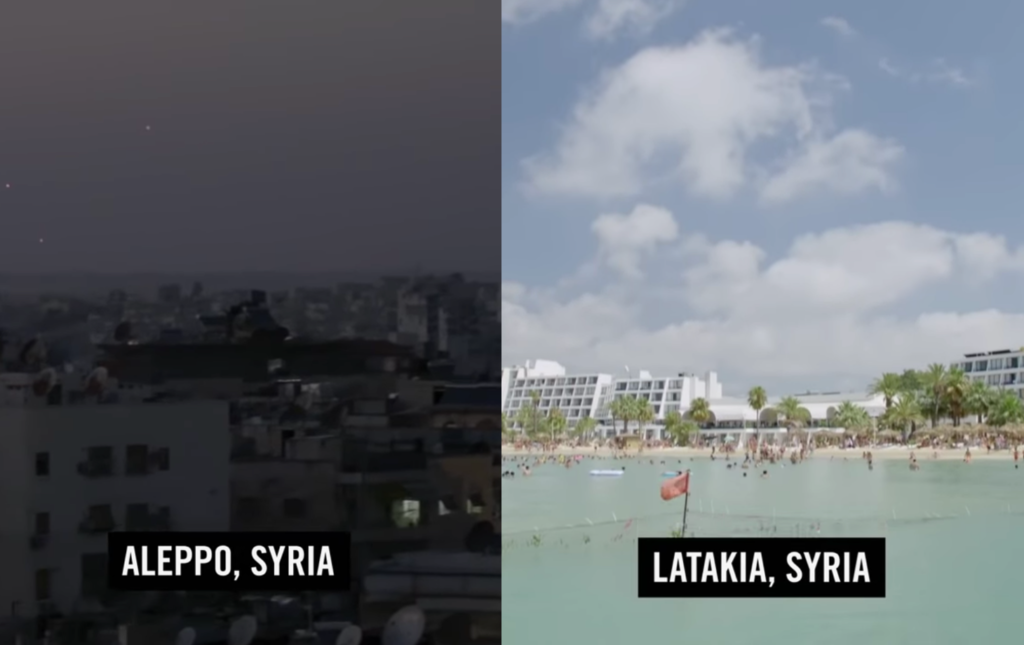It’s a common feature of epidemics and pandemics: one city or village will be decimated and the next one over is unscathed. The same thing also tends to happen with civil strife. Some regions of a city or country will be literally aflame, while nearby, people crowd into restaurants and shops as if nothing’s wrong.
In any kind of contagion-based disaster (pandemic, civil unrest, outright civil war), the trauma is always unevenly distributed within a population. Real-world social breakdowns rarely look like the movies, where everyone, everywhere is equally screwed in roughly the same timeframe.
The clustering effect that goes hand-in-hand with social and viral contagions often gives rise to a kind of cognitive dissonance that I’ve taken to calling the split-screen effect.
Understanding the split-screen effect
The split-screen effect is that feeling of being frightened and disoriented that overcomes you when you:
- first watch a spectacle that disrupts your sense of “normal” unfold right in front of you — either first-hand or on a screen
- and then turn around to see crowds somewhere nearby carry on in total apparent obliviousness to the turmoil.
Take, for instance, last summer’s breakdown of law and order in parts of Venezuela. Some cities (and areas within cities) were doing well enough that Western journalists sympathetic to Maduro could film themselves milling around in a shopping mall and eating ice cream. Meanwhile, hostile journalists were broadcasting scenes of riots and shooting from another part of town.
(Note: I do not endorse anything by Max Blumenthal, and I link the below only to show how easy it is to exploit the split-screen effect to tell whatever story you want about a region in turmoil.)
An even more extreme example is Syria. In this Vice documentary, you can get whiplash watching them move from a bombed out city to the coast of Latakia, where beach-going crowds seem to be having a perfectly normal day.
Split-screen effect in the United States
This week in the United States, many of us are experiencing this split-screen effect in real-time. I’ve already talked to multiple people who have experienced exactly this phenomenon just this week. I’ve been reassuring them that this is actually pretty common in situations of social upheaval.
Here in Texas, Dallas’s Deep Ellum district has been thoroughly sacked from multiple nights of total lawlessness. But if you drive a few miles away, you’ll see happy families packed into a local taco chain. People in other parts of the Dallas metro are are just generally carrying on as if nothing’s happening. My Dallas-area friend who has been watching Deep Ellum burn via Twitter grapples with serious cognitive dissonance every time he goes out.
In Minneapolis, our Senior Blog Editor, Kelsey Donk, has been reporting from her home right in the heart of the unrest. She reports that this morning she a took walk and just a few blocks away from her home things seemed totally normal, despite the fact that her local post office burned a few nights ago. It was disorienting to suddenly go from sheltering in place as the National Guard moved through her neighborhood to a nice, peaceful walk through an undisturbed part of the city.
How to cope with the split-screen effect
Remember the effect is ‘normal’
Just knowing that the split-screen effect is a real and expected part of civil unrest scenarios is the first step in coping with it. If you understand that this is just a standard thing that happens in times of societal disarray, then you can keep yourself from becoming too disoriented. The contrast may feel surreal to you. That’s especially true if you live in an affected area or follow the unrest closely, but this experience is as ‘normal’ a part of violent upheavals as police batons.
Know that media can (and will) use it
You should also remember that the split-screen effect means media types can tell whatever story they want to tell. As in the Venezuela clip above, there are some outlets who focus on the peaceful and joyful parts of the present protests, and others who focus purely on the violence and chaos.
All of this stuff—the beautiful and the ugly—is really happening and really matters, but you have to be extremely careful in using news reports to develop a sense of how much of what is happening where.
Don’t get complacent
Finally, awareness of the split-screen effect should prevent you from assuming that things will stay normal in your area just because they look and feel normal to you right now. They may not. All that stuff you’re seeing on the “collapse” side of the screen may come to your doorstep overnight. You need to prepare yourself to either shelter in place or move, depending on your resources and the flow of events.
Ultimately, the best thing to do with the split-screen effect is to treat the bad side of the screen as a preview of what you’ll be dealing with at some point—if you aren’t already. You can watch carefully and take notes so that if the contagion moves to your doorstep, you have a plan and the means to execute it.


You are reporting the comment """ by on